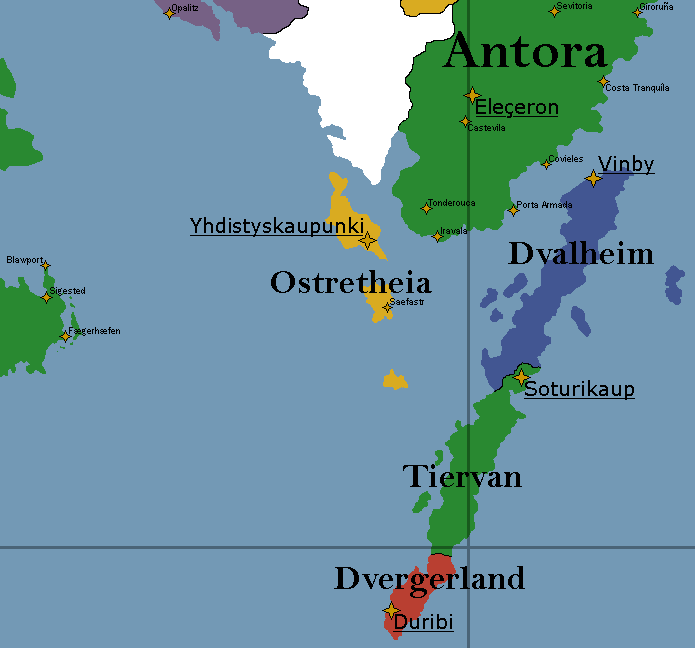This is a joint claim between me and Stander.
Flag:
Nation Name (long): Federal Republic of Ostretheia
Nation Name (short): Ostretheia
Motto: Unity, Reconciliation, Brotherhood
National Animal:
National Flower/Plant:
National Anthem:
Capitol: Yhdistyskaupunki
Largest City: Saefastr
Demonym: Ostretheian
Language: Fefsen, Tretridian, Norgsveltian, Tierish, Dvergian
Species: Human, Elves, Dwarves
Population: 2,079,780
Government type: Liberal democracy under a federal directorial presidential republic
Leader(s): Co-President Albert Viitala, Co-President Cormac Fearchar Midhir
Legislature: National Assembly
Formation: 1984
Total GDP: SHD $16,933,568,760
GDP per capita: SHD $8,142
Currency: Ostretheian Mark
Calling Code:
ISO 3166 code: OT, OTR
Internet TLD: .ot
Historical Summary: Evidence of contact between people of what is now Ostretheia and Ulvrikia, as well as Trinteria, date back to antiquity, through both written Trinterian and Ulvrikian records, as well as archaeological finds within Ostretheia itself.
The first unified Ostretheian polity, the Kingdom of Ostretheia, was founded circa 800, and lasted until the 14th century when it was conquered by the Trinterian Commonwealth. However, as the Commonwealth rapidly destabilized not long after the start of the 16th century, vestiges of the old Kingdom started preparing a full-scale rebellion with support from Tretrid. The Ostretheian Independence War was finally launched in 1512 against a Trinteria engulfed in civil war, and was soon able to reestablish the Kingdom.
However, this occurred at the height of Tretridian power in Novaris. Tretrid forced Ostretheia to become a client state. This state of affairs lasted until 1651, when Ostretheia was able to break away from Tretrid due to the turmoil of the War of the Tretridian Succession.
In 1770, when Gustaf II of Norgsveldet declared himself the Fylkir, Tretrid responded by refusing to recognize his religious authority. This effected a schism in Ulvriktru between what would become the Gustafic and Gothiric branches of the religion. Ostretheia sided with Norgsveldet.
In 1779, a rebellion sprung up against the Kingdom by Gothiric Republican movements. This rebellion quickly turned into another theater of the Ulvriktru Wars of Religion between Tretrid and Norgsveldet. The Gothiric Republican movements (and Tretrid) proved victorious, leading to the overthrow of the Kingdom (and the exile of its royals to Norgsveldet) and the establishment of the Gothiric Republic of Ostretheia.
Throughout the course of the 19th century, the development of nationalism would create a rift between the ethnically Fefsen population and the ethnically Tierish and Dvergian parts of, leading to several uprisings against Ostretheian rule that were put down.
This ethnic instability soon turned the islands into another battleground of the Great War, as Mirhaime sought to take advantage of Tretrid’s involvement in the front in Celanora to incite and intervene in another such conflict. Tretrid responded in kind, backing the government, resulting in the two powers clashing over control of the islands. The government proved victorious over the secessionist factions, though this matter would be one of the reasons why Mirhaime and Tretrid were rather hostile to each other for much of the 20th century.
In the 1950s, liberals entered the government and sought to reform the government to a federated structure to give equitable representation to the two ethnic groups (since the structure of the Gothiric Republic favored the Tierish and Dvergian populations). This was met with anxiety from Tretrid, who feared that would cause Ostretheia to become neutral where it previously had sided with Tretrid in the Novaran Cold War, as well as Mirhaime, who worried that an independent Ostretheian foreign policy was harder to bring in alignment with their own than even a Tretrid-aligned Ostretheia. In response, the RIS and KUSA sponsored two competing coups, which quickly devolved into a civil war between the RIS-backed and KUSA-backed sides. The RIS-backed faction proved victorious, and installed a military dictatorship.
As Tretrid and Mirhaime entered a detente starting at the end of the 1970s, their two leaders met in Paravena, Lapinumbia in 1981 and issued a joint declaration resolving to settle the matter of Ostretheia. The Ostretheian dictator retired in 1982 under encouragement by the Tretridian government, and later that year the RIS and KUSA assassinated various key members of the Ostretheian government. This destabilized the dictatorship, leading to a few attempted coups and countercoups, before causing Ostretheia to break into outright civil war.
Tretrid and Mirhaime jointly announced a military intervention and occupation of Ostretheia, using the political instability as a rationale, and proceeded to give power to pro-democracy factions in Ostretheia.
The Ostretheian constitution was written by these factions, though many of its provisions in reality dictated by the Tretridian and Mirhamian governments, which had secretly agreed to the frame of the new Ostretheian government back in the Paravena conference. With the new constitution in place, the Tretridio-Mirhaimian occupation was brought to an end in 1984, and the Federal Republic of Ostretheia was born.
The Federal Republic of Ostretheia’s constitutional structure was intentionally designed to only make the country stable with both the political support of Tretrid and Mirhaime to ensure the balance of power between the two countries.
